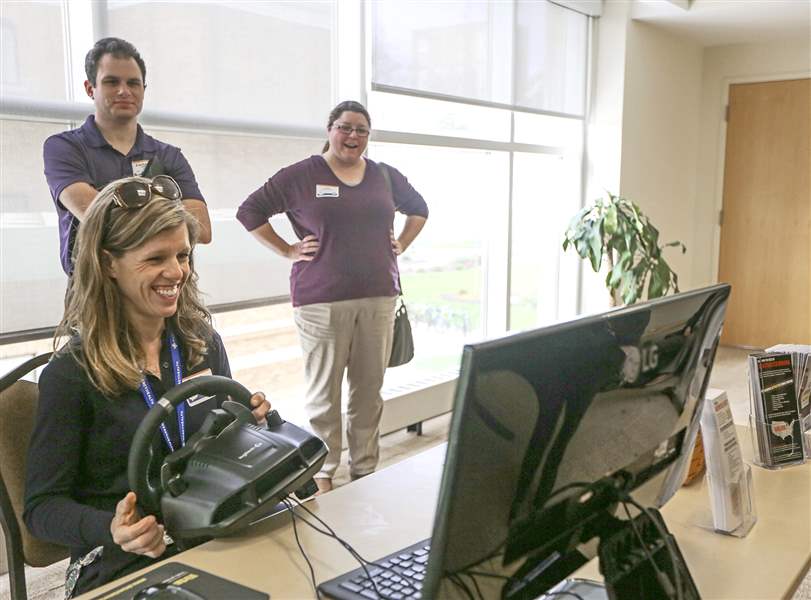
Professor: Road-safety culture not found in U.S.
Toughen penalties for distracted driving
4/12/2017
Nicole Knepper, education and outreach coordinator at Mercy Health St. Vincent Medical Center, tries the steering wheel of a driving simulator during a safety meeting as part of the ‘Toward Zero Deaths’ conference series at Bowling Green State University.
THE BLADE/JETTA FRASER
Buy This Image
BOWLING GREEN — It might not seem like sending a text message or taking a cell-phone call while waiting for a red light to turn green is a driving distraction, but Paul Atchley says otherwise.
Studies show it takes 28 seconds “to fully re-engage” with the driving environment after using a smart phone at an intersection, Mr. Atchley told an audience of about 100 public safety, medical, education, highway engineering, and insurance professionals during a lecture here Tuesday.
And while people repeatedly acknowledge in surveys that using electronic devices behind the wheel is risky, they overestimate their own observational skills and their brains’ ability to process what they see, said Mr. Atchley, a University of Kansas psychology professor who’s studied the cognitive factors in driving for more than 25 years.
Even talking on a hands-free cell phone — deemed a safer alternative to hand-held phones by some states that have banned driver use of the latter — degrades driver performance significantly, the professor said during his program in Bowling Green State University’s Bowen-Thompson Student Union.
Using an electronic device “in any manner while you’re driving, you’re probably about as good as a drunk driver, and maybe a little worse,” he said, noting that in a University of Utah simulator study, drunks were better than cell-phone users at avoiding crashes because at least they paid attention to the road.
The result, Mr. Atchley said, is that some form of distraction is probably responsible for about 80 percent of traffic crashes, even if the number of crash reports citing distraction as a factor is far lower.
“Multitasking is a myth,” he said, arguing that at best the human brain is capable of evaluating four different stimuli at a time, and the driving environment alone demands at least that much attention.
Conversation with an in-vehicle passenger is safer, he said, because passengers are generally aware of what’s happening on the road and usually stop conversation when driving becomes especially challenging. Some passengers serve as extra sets of eyes on and around the road, he said.
Michelle May, manager of the Ohio Department of Transportation’s highway safety program, prefaced Mr. Atchley’s presentation with state data showing that, starting in 2011, Ohio traffic crashes blamed on distracted driving began increasing sharply — from 12,953 that year to 21,438 last year.
Annual fatalities in distracted-driving crashes roughly doubled, she said. And those numbers are surely low, Ms. May said, because “people will not admit to being in a distracted-driving crash, out of fear of liability and possibly out of shame.”
Mr. Atchley said that, with hundreds of studies conducted since 1969 — when a first report about the effects of mobile telephones was published — there’s no need for further research.
“We don’t have a road-safety culture in the United States,” he said, before stating that education alone will not change behavior, just as drunken driving was not successfully reduced until stricter penalties were enacted and enforced.
Mr. Atchley used that analogy to urge his audience not to engage in phone conversations or text exchanges with people they know are driving.
“Don’t be the bartender in the back seat pouring them tequila shots,” he said. “Our brain’s not going to help us here, because we want to use these devices.”
“My kids have heard the message,” audience member Karen Pennington, an educator with the Fulton County Health Department, said afterward.
Asked if her children use electronic devices while driving, she said, “They say they do not. They’re very aware of it because we talk about it.”
Capt. John Altman, commander of the Ohio Highway Patrol’s Findlay District headquarters, said programs like Mr. Atchley’s encourage people involved in traffic safety “to go out and really be a voice against distracted driving.”
The program was part of a quarterly “Toward Zero Deaths” conference series ODOT began this year and plans to hold at varying locations across the state.
Contact David Patch at: dpatch@theblade.com or 419-724-6094.